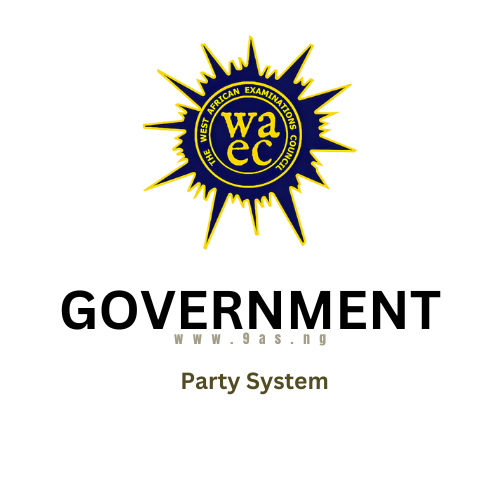THEORY
1. Why will the one-party system not be a good option for Nigeria?
2. Describe any five problems associated with a single-party system of government..
3. What are the merits and demerits of a multi-party system of government?
4. a) Highlight the merits of a two-party system.
(b) Highlight the demerits of a two-party system.
5. Highlight any five roles of minority parties in a multi-party democracy.
6. Differentiate between a de jure and de facto one-party system,
7. Outline four advantages of a multi-party system.
OBJECTIVES
1. One major disadvantage of a two-party system is that It
A. does not allow citizens to participate in politics.
B. divides the country into factions.
C. creates two countries.
D. stifles public opinion.
2. A major weakness of a one-party system is that it
A. encourages the emergence of dictators.
B. ensures freedom of political choice.
C. negates the principle of one man one vote.
D. requires a bicameral legislature.
3. A multi-party system often leads to the formation of
A. coalition government.
B. dual government.
C. dictatorial government.
D. monarchical government.
4. Under a two-party system, the opposition party is as important as the ruling party because it
A. has equal number of supporters as the ruling party.
B. is as strong as the ruling party.
C. may force the government to resign.
D. is the alternative government.
5. One-party system leads to
A. theocracy.
B. diarchy.
C. democracy.
D. dictatorship.
6. In a democratic state the party system that usually operates is
A. elite party.
B. one-party.
C. multi-party.
D. mass party.
7. The operation of multi-party system often leads to the formation of a
A. very strong executive.
B. confrontational government.
C. multi-governmental system.
D. coalition government.
8. In which of the following party systems are all shades of opinions and interests adequately
represented?
A. Zero-party.
B. One-party.
C. Two- party.
D. Multi-party.
9. One demerit of a one-party system is that it encourages
A. red-tapism,
B. dictatorship.
C. democracy.
D. development.
10. A multi-party system often leads to the formation of a
A. coalition government.
B. very strong executive.
C. dictatorial government.
D. confederal government.
11. In a multi-party state various interests and shades of opinion
A. are not represented.
B. have the opportunity to be represented.
C. are strongly represented.
D. should not be represented.
12. Two-party system implies that only two parties
A. exist in the country.
B. can contest elections.
C. can form a coalition.
D. can register members.
13. A political system in which there is only one legalized political party is called
A. de-jure one-party system.
B. de-facto one-party system.
C. totalitarian single party system.
D. mass party system.
14. A one-party system is common to
A. democratic government.
B. totalitarian government.
C. representative government.
D. monarchical government.
15. A government that is constituted by several parties after a general election is referred to as
A. elite government.
B. fascist government.
C. illegitimate government.
D. national government.
16. In a one-party state
A. there is only one dominant party.
B. the legislature is unicameral.
C. only the workers’ party is allowed to exist.
D. the ruling party is the only legal party.
17. Which of the following West African countries practiced a one-party system?
A. Benin.
B. Nigeria.
C. Ghana.
D. Liberia.
18. In a one-party state
A. only one party is recognized officially and there is no legal opposition.
B. only one political party wins elections all the time.
C. two or more parties join together after a general election.
D. the government has power to disband other political parties.
19. The party system operated by a country is determined by the
A. leaders of political parties.
B. elite of the country.
C. nature of competition and interaction within and between political parties.
D. electoral Commission.
20. A multi-party system often leads to
A. unitary government.
B. dictatorial government.
C. coalition government.
D. parliamentary government.
21. Liberal democracy thrives best in a
A. fascist system.
B. multi-party system.
C. feudal system.
D. one-party system.
22. Which of the following exists in a one-party state?
A. Only the workers’ party is allowed to exist.
B. Only the students’ party is allowed to exist.
C. Elections to the legislature are held at the party’s conference.
D. The ruling party is the only legal party.
23. Which of the following party systems best represents all shades of opinions?
A. Multi-party.
B. Two-party.
C. One-party.
D. Elite-party.
24. The practice of multi-party system in West Africa tends to promote
A. sectionalism and factionalism.
B. national integration.
C. social discrimination.
D. economic integration.
25. In order to preserve the liberties of individuals in a country, which of the following systems is
encouraged?
A. Feudalism.
B. Communism.
C. Multi- party system.
D. One-party system.
26. A state with more than one dominant political party of nearly equal strength is operating
A. a mass party.
B. a multi-party system.
C. an elitist party.
D. a charismatic party.
27. One-party system is favourably disposed to
A. national cohesion.
B. sectarian demands.
C. rule of law.
D. religious tolerance.
28. One-party,system is a feature of
A. democratic states.
B: military regimes.
C. republican states.
D. communist states.
29. One major disadvantage of a two-party system is that
A. choice of political associations is limited.
B. choice of party candidates is without limit.
C. political education is for party members only.
D. party leaders are allowed to contest elections.
30. One-party system of government may lead to
A. stateless society.
B. autocracy.
C. liberal democracy.
D. oligarchy.
31. The most important merit of a multi-party system is that It
A. guarantees the viability of many parties.
B. disallows smaller political parties from gaining political power.
C. reduces oppression within the various parties.
D. gives representation to the widest shades of opinion and interest.
32. A major weakness of one-party system is that it
A. does not aggregate public opinion.
B. negates the principle of one man one vote.
C. ensures freedom of political choice.
D. encourages dictatorship.
33. In a two-party system, only two political parties
A. exist in the country.
B. dominate the political scene.
C. register their members.
D. undertake political education.
34. Two-party system of government enables the electorate to
A. participate in government.
B. choose freely between alternatives.
C. mobilize favourable opinion for government.
D. sympathize with government.
35. Many African leaders adopted the single-party system of government after independence in order
to promote
A. fundamental human rights.
B. constitutional government.
C. national unity.
D. competitive politics.
36. A major advantage of a one-party system is that it
A. prevents dictatorship.
B. promotes unity.
C. allows opposition.
D. promotes freedom and liberty.
37. Those who believe in democracy and good governance are opposed to a single party system
because it
A. encourages weak leadership.
B. does not ensure national unity.
C. curtails personal liberty.
D. encourages divisiveness.
38. An advantage of a two-party system is that, it
A. simplifies the electoral process.
B. ensures winner takes all.
C. protects the electoral commission.
D. protects the electorate from vote buying.
39. One-party system encourages and often end up in
A. democracy.
B. dictatorship.
C. fair electoral contest.
D. freedom of expression.
40. One advantage of multi-party system is that, the
A. electorate have wide range of choice.
B. educated elite represents their people in parliament.
C. executive is not restrained by law.
D. party in power creates employment for all sympathizers.
41. Multi-party system is saddled with the problem of
A. divisiveness
B. limited choice
C. weak opposition
D. political consciousness
42. A coalition government is a common feature of a
A. two party system
B. multi-party system
C. one party system
D. non-party system



